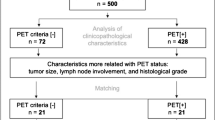Abstract
Purpose
Using a “spontaneous” mammary mouse tumor model we set out to develop diagnostic approaches for non-invasive P-glycoprotein (P-gp) staging and response prediction.
Methods
99mTc-MIBI efflux rates were measured using a gamma camera in three Brca1 −/−; p53 −/− mouse mammary tumors that have different Mdr1a/b expression levels. The efflux rates were quantified in the 10–30-min period after injection. In addition to the P-gp-mediated efflux measurements in untreated tumors, efflux measurements were performed in the presence of the P-gp inhibitor tariquidar. Volumetric doxorubicin response patterns for the different tumors were determined and correlated with the efflux rates.
Results
Combined pre- and post-inhibitor treatment imaging of P-gp-mediated efflux correlated with Mdr1a/b expression: basal (0.0026, p = 0.16), 3-fold Mdr1a/b (0.0074, p = 0.02), and 17-fold Mdr1a and 46-fold Mdr1b (0.012, p = 0.002). Based on the doxorubicin response of these tumors, we generated a computer-aided diagnosis model that predicts the likelihood of drug resistance.
Conclusions
Quantified 99mTc-MIBI efflux has potential to: (1) noninvasively assign Mdr1 expression levels, (2) predict the therapeutic impact of a P-gp inhibitor, and (3) noninvasively assess the probability of drug resistance.



Similar content being viewed by others
References
Gottesman M, Fojo T, Bates SE. Multidrug resistance in cancer: role of ATP-dependent transporters. Nat Rev Cancer 2002;2:48–58.
O’Driscoll L, Clynes M. Biomarkers and multiple drug resistance in breast cancer. Curr Cancer Drug Targets 2006;6:365–84.
Leonard GD, Fojo T, Bates SE. The role of ABC transporters in clinical practice. Oncologist 2003;8:411–24.
Faneyte IF, Kristel PM, van de Vijver MJ. Determining MDR1/P-glycoprotein expression in breast cancer. Int J Cancer 2001;93:114–22.
Elsinga PH, Franssen EJF, Hendrikse NH, Fluks L, Weemaes AMA, van de Graaf WTA, et al. Carbon-11-labeled daunorubicin and verapamil for probing P-glycoprotein in tumors with PET. J Nucl Med 1996;37:1571–5.
Piwnica-Worms D, Chiu ML, Budding M, Kronauge JF, Kramer RA, Croop JM. Functional imaging of multidrug-resistant P-glycoprotein with an organotechnetium complex. Cancer Res 1993;53:977–84.
Sharma V, Piwnica-Worms D. Metal complexes for therapy and diagnosis of drug resistance. Chem Rev 1999;99:2545–60.
Piwnica-Worms D, Rao VV, Kronauge JF, Croop JM. Characterisation of multidrug resistance P-glycoprotein transport function with an organotechnetium cation. Biochemistry 1995;34:12210–20.
Palmedo H. What can we expect from Mdr breast cancer imaging with sestamibi? J Nucl Med 2002;43:526–30.
Rottenberg S, Nygren AOH, Pajic M, van Leeuwen FWB, van der Heijden I, van de Wetering K, et al. Selective induction of chemotherapy resistance of mammary tumors in a conditional mouse model for hereditary breast cancer. Proc Natl Acad Sci USA 2007;104:12117–22.
Sharom FJ. Shedding light on drug transport: structure and function of the P-glycoprotein multidrug transporter (ABCB1). Biochem Cell Biol 2006;84:979–92.
Pusztai L, Wagner P, Ibrahim N, Rivera E, Theriault R, Booser D, et al. Phase II study of tariquidar, a selective P-glycoprotein inhibitor, in patients with chemotherapy-resistant, advanced breast carcinoma. Cancer 2005;104:682–91.
Murren JR. Modulating multi drug resistance; can we target this therapy? Clin Cancer Res 2002;8:633–5.
Liu X, Holstege H, van der Gulden H, Treur-Mulder M, Zevenhoven J, Velds A, et al. Somatic loss of BRCA1 and p53 in mice induces mammary tumors with features of human BRCA1-mutated basal-like breast cancer. Proc Natl Acad Sci USA 2007;104:12111–6.
Johnson RA, Wichern DW. Applied multivariate statistical analysis. 3rd ed. New Jersey: Prentice-Hall; 1982.
Gilhuijs KG, Deurloo EE, Muller SH, Peterse JL, Schultze Kool LJ. Breast MR imaging in women at increased lifetime risk of breast cancer: clinical system for computerized assessment of breast lesions initial results. Radiology 2002;225:907–16.
Ciarmiello A, Del Vecchio S, Silvestro P, Potena MI, Carriero MV, Mainolfi C, et al. Tumor clearance of technetium 99m-sestamibi as a predictor of response to neoadjuvant chemotherapy for locally advanced breast cancer. J Clin Oncol 1998;16:1677–83.
Liu Z, Stevenson GD, Barrett HH, Kastis GA, Bettan M, Furenlid LR, et al. Imaging recognition of multidrug resistance in human breast tumors using 99mTc-labeled monocationic agents and a high resolution stationary SPECT system. Nucl Med Biol 2004;31:53–65.
Duan XY, Wang JS, Liu M, Guo YM. Technetium-99m-hexakis-2-methoxyisobutylisonitrile scintigraphy and multidrug resistance-related protein expression in human primary lung cancer. Ann Nucl Med 2008;22:49–55.
Pichler A, Zelcer N, Prior JL, Kuil AJ, Piwnica-Worms D. In vivo RNA interference-mediated ablation of MDR1 P-glycoprotein. Clin Cancer Res 2005;11:4487–94.
Chen CC, Meadows B, Regis J, Kalafsky G, Fojo T, Carrasquillo JA, et al. Detection of in vivo P-glycoprotein inhibition by PSC 833 using Tc-99m sestamibi. Cin Cancer Res 1997;3:545–52.
Agrawal M, Abraham J, Balis FM, Edgerly M, Stein WD, Bates S, et al. Increased 99mTc-Sestamibi accumulation in normal liver and drug-resistant tumors after the administration of the glycoprotein inhibitor, XR9576. Clin Cancer Res 2003;9:650–6.
Acknowledgments
This research was supported, in part, by the Technology Foundation, Applied Science Division of NWO, and the Technology Program of the Ministry of Economic Affairs (STW BGT 7528 Veni), KWF (NKI 2006-3566), and ZON-MW 945-04-512. We thank Susan Bates (NIH, Bethesda, MD) for providing tariquidar. We also thank Renato Valdes-Olmos and the technical staff of the Department of Nuclear Medicine at the NKI-AVL for their support. Lastly, we gratefully acknowledge Piet Borst for critically reading the manuscript.
Author information
Authors and Affiliations
Corresponding author
Rights and permissions
About this article
Cite this article
van Leeuwen, F.W.B., Buckle, T., Kersbergen, A. et al. Noninvasive functional imaging of P-glycoprotein-mediated doxorubicin resistance in a mouse model of hereditary breast cancer to predict response, and assign P-gp inhibitor sensitivity. Eur J Nucl Med Mol Imaging 36, 406–412 (2009). https://doi.org/10.1007/s00259-008-1010-z
Received:
Accepted:
Published:
Issue Date:
DOI: https://doi.org/10.1007/s00259-008-1010-z




